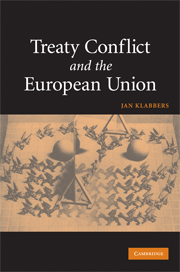Book contents
- Frontmatter
- Contents
- Preface
- Table of cases and official materials
- Table of treaties and instruments
- PART I Setting the scene
- PART II International law
- PART III EC law
- 6 The EC and anterior treaties
- 7 The UN Charter and the European Convention
- 8 Posterior treaties: conceptual issues
- 9 Posterior treaties: practice
- 10 Conclusions
- Bibliography
- Index
8 - Posterior treaties: conceptual issues
Published online by Cambridge University Press: 03 February 2010
- Frontmatter
- Contents
- Preface
- Table of cases and official materials
- Table of treaties and instruments
- PART I Setting the scene
- PART II International law
- PART III EC law
- 6 The EC and anterior treaties
- 7 The UN Charter and the European Convention
- 8 Posterior treaties: conceptual issues
- 9 Posterior treaties: practice
- 10 Conclusions
- Bibliography
- Index
Summary
Introduction
The EC Treaty, as seen in the previous two chapters, in article 307 contains its own rule on what to do with treaties concluded by EC member states before they joined the EC, and the Court of Justice of the EC has had on various occasions to clarify the scope of that provision. Perhaps as a result, article 307 has also met with some treatment in the academic literature, albeit only in the form of law review articles or a few pages here and there in broader studies on EU external relations law.
By contrast, fairly little has been written about what to do with treaties concluded by or between EC member states after they have joined the EC (posterior treaties, as I shall refer to them). With the exception of some of the writings of Bruno deWitte, notmuch attention has been paid to posterior treaties as such; at best, the topic is treated sideways (or by extension) in the textbooks on external relations of the EC (if at all), in writings on the connections between EC law and international law, and in writings on differentiation in EU law. And the EC Treaty itself lacks a provision on posterior treaties, something that is sometimes deplored in the scarce academic literature.
The aim of this chapter and the next is to clarify the legal position of posterior treaties. The next chapter will have a look at practice; the present chapter aims first and foremost to address some conceptual issues, concentrating in particular on four questions.
- Type
- Chapter
- Information
- Treaty Conflict and the European Union , pp. 175 - 199Publisher: Cambridge University PressPrint publication year: 2008



